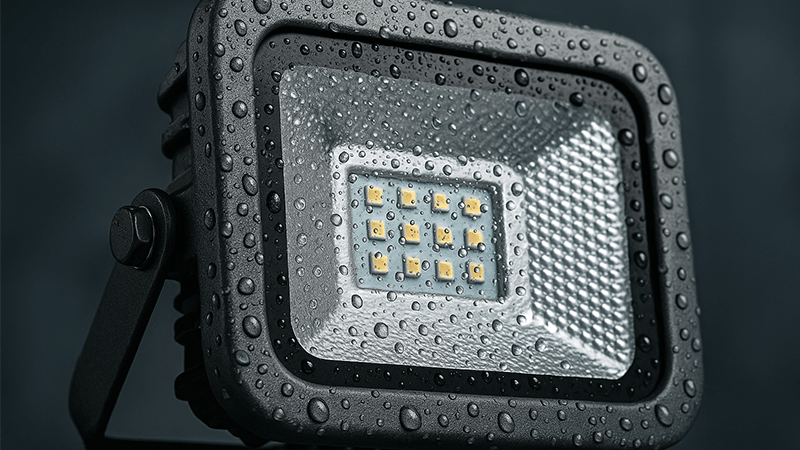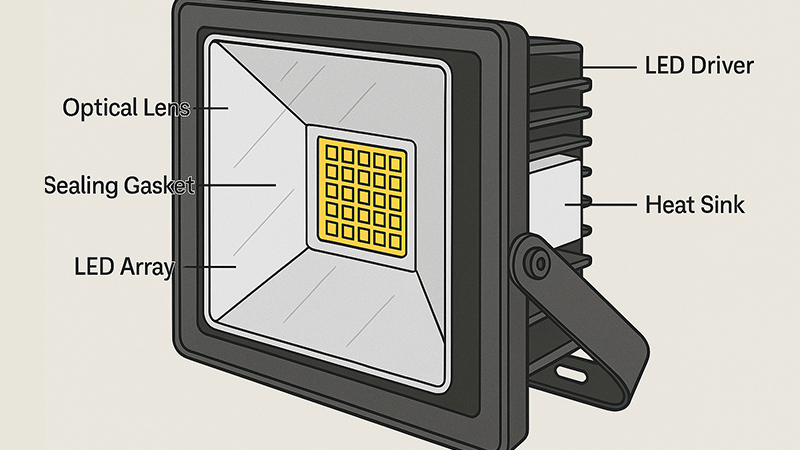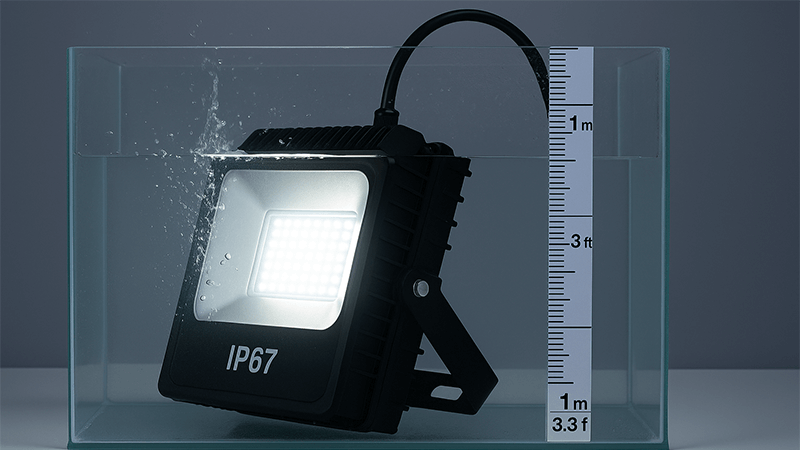Last Updated on: September 1, 2025Choosing the wrong IP rating for your floodlights can lead to costly failures. Imagine your installations failing prematurely, damaging your reputation. Understanding the real difference protects your projects.
IP65 protects against low-pressure water jets from any direction, like rain. IP67 protects against temporary immersion in water up to 1 meter deep. The best choice depends on the specific risk—splashing water versus potential submersion—and is not always as simple as a higher number.

The numbers on an IP rating chart seem simple. You see IP65 and IP67 and assume one is just a step up from the other. As someone who has been manufacturing LED lights for years, I can tell you the reality is much more complex. The tests are specific, but the real world is messy. A higher rating isn’t always the better choice, and sometimes it can even introduce new problems. To really make the right purchasing decision, you need to look beyond the chart and understand what is happening inside the fixture. Let’s dive into what these ratings really mean for the performance and longevity of your floodlights.
Is IP67 Always Better Than IP65 for Floodlights?
You assume a higher number means a better, safer product. This simple assumption can lead you to overspend on protection you do not need or, worse, choose a light that fails for unexpected reasons.
Not necessarily. While IP67 signifies higher protection against water immersion, this tight seal can sometimes cause failures that IP65 lights avoid, particularly due to internal pressure changes. The "better" choice truly depends on the specific environment, maintenance plan, and the floodlight’s engineering design.

This might sound counterintuitive, but I have seen it happen. The most important factor here is something we in the industry call the internal pressure differential. It is a critical concept that is not covered by a standard IP test.
The Pressure Cycle Paradox
When you turn on a powerful LED floodlight, the LED chips and the driver generate significant heat. The internal air temperature can rise quickly. This causes the air inside the sealed housing to expand, creating positive pressure. When you turn the light off, or when it cools at night, the opposite happens. The internal air cools and contracts, creating a vacuum, or negative pressure.
This constant cycling between positive and negative pressure puts immense stress on the seals. An IP67 fixture is sealed so tightly that it essentially becomes a pressure vessel. It tries to "breathe" to equalize the pressure with the outside air. During the cooling phase, this vacuum effect actively sucks at every potential entry point—the gasket seals, the cable glands, any microscopic imperfection. If there is any moisture on the outside of the light, this vacuum will pull that moisture, or even water, into the fixture. Over many cycles, this accumulated moisture leads to condensation, corrosion on the circuit boards, and eventual failure.
An IP65 fixture, being slightly less "perfectly" sealed, can sometimes handle this pressure cycle better. A better solution I often recommend is a well-designed IP66 fixture that incorporates a breathable membrane, like a Gore-Tex vent. This vent allows air and water vapor to pass through, equalizing the pressure without letting liquid water in. This approach directly addresses the root cause of the pressure problem, often resulting in a more reliable product in the long run than a sealed-for-life IP67 unit.
| Factor |
IP65/IP66 with Vent |
Tightly Sealed IP67 |
| Pressure Handling |
Equalizes pressure, preventing vacuum. |
Builds up internal pressure/vacuum. |
| Moisture Risk |
Vents out internal moisture vapor. |
Traps moisture, pulls more in via vacuum. |
| Seal Stress |
Lower stress on gaskets and seals. |
High stress on all seals during cycling. |
| Long-Term Reliability |
Often higher due to stable internal environment. |
Can be lower if pressure cycling leads to ingress. |
Can an IP65 Floodlight Really Withstand Heavy Rain?
Worried your IP65-rated lights will not survive a serious downpour? The last thing you need is a project full of failed lights after the first storm, leading to angry clients and costly replacements.
Yes, absolutely. A properly manufactured IP65 floodlight is designed to withstand heavy rain. The official test involves directing powerful water jets at the fixture from all angles, a condition far more severe than even wind-driven storm rain. For most outdoor applications, IP65 provides robust protection.

I understand the concern. When a client sees "water jets" in the description, they might not immediately connect that to their local weather. Let me break down the difference. The test for IP65 certification is very specific. It requires spraying the enclosure with a 6.3mm nozzle that delivers 12.5 liters of water per minute, from a distance of about 3 meters, for at least 3 minutes, pointed at every surface. This simulates much more than just falling rain. It is like being sprayed forcefully with a garden hose. Heavy rainfall, even in a typhoon or hurricane, does not typically have that kind of focused, sustained pressure.
Gaskets: The Unsung Heroes of IP Ratings
However, just because a product has an IP65 certificate does not mean all IP65 products are created equal. The long-term reliability comes down to the quality of the components you cannot see, especially the gaskets. The gasket is the primary barrier that keeps water out. Its material and the mechanical design of the seal are critical.
In our factory, we primarily use high-grade silicone gaskets. Silicone is excellent because it resists high temperatures from the LEDs and maintains its elasticity over a long time. Cheaper lights might use EPDM or other rubber materials that can become brittle when exposed to heat and UV radiation.
The other key factor is "compression set." This is the tendency of a gasket to permanently deform under pressure and heat over time. A poor-quality gasket will lose its ability to spring back, creating micro-gaps that allow water to seep in. A well-designed floodlight ensures the gasket is compressed evenly and not over-stressed, maximizing its lifespan. This is why when I work with clients like Shaz, I emphasize that they should ask potential suppliers about their gasket material and seal design, not just the IP rating. A great IP65 light with a superior gasket will always outperform a cheap one over the lifetime of a project.
| Gasket Material |
Temperature Resistance |
UV Resistance |
Compression Set |
Typical Use |
| Silicone |
Excellent (-55°C to 230°C) |
Excellent |
Low (Good) |
High-quality, long-life LED fixtures. |
| EPDM |
Good (-50°C to 150°C) |
Good |
Medium |
General outdoor applications, often a cost-saving choice. |
| Neoprene |
Fair (-40°C to 120°C) |
Moderate |
Medium |
Used where oil resistance is also needed. |
So What Is the Best IP Rating for Outdoor Floodlights?
You need a simple answer for the "best" IP rating for your projects. But a one-size-fits-all approach is risky. It can lead to poor long-term results and unhappy clients across different types of installations.
There is no single "best" rating. The ideal choice depends on the application. IP65 is the standard for most outdoor locations. IP66 is for areas exposed to powerful jets like wash-downs. IP67 is only needed where fixtures risk temporary submersion in water.

The key flaw in relying only on the IP chart is the mismatch between the clean, controlled lab test and the harsh, unpredictable real world. An IP test is a one-time event performed on a brand-new product for a very short duration. It does not account for years of thermal cycling, UV degradation, vibrations from traffic, or exposure to salt spray in coastal areas.
As a manufacturer, I guide my partners to think about the environment first, then the rating. This ensures they get the right performance without overpaying for protection they do not need.
Matching the Rating to the Real World
Let’s break it down by common applications:
- General Building Facades, Parking Lots, Billboards: Here, the primary risk is rain, from gentle showers to wind-driven downpours. An IP65 rating is perfectly sufficient and provides a robust, reliable solution.
- Coastal Areas, Ship Docks, Food Processing Plants: These environments introduce new risks. Coastal areas have corrosive salt spray, and other locations like food plants or truck bays involve regular, high-pressure wash-downs. Here, I would strongly recommend IP66. The "6" in IP66 protects against powerful water jets (100 liters/minute), which is a much closer simulation of a pressure washer or heavy sea spray.
- Ground-Level Landscape Lighting, Areas with Poor Drainage: If you are installing lights in planters, at the base of fountains, or in low-lying areas prone to flooding, then the risk of temporary submersion is real. This is where an IP67 rating becomes necessary. It is specifically designed to protect the fixture if it ends up underwater for a short period.
Here is a simple decision matrix I use:
| Environment |
Key Water Risk |
Recommended IP Rating |
My Rationale |
| Wall/Pole Mounted (General) |
Rain, wind-driven rain |
IP65 |
Provides excellent protection against all forms of rain. Cost-effective and reliable. |
| Coastal, Marine, Wash-down |
Powerful jets, heavy spray |
IP66 |
The higher jet-pressure rating is critical for durability against cleaning or sea spray. |
| Ground Level, Flood-Prone |
Temporary submersion |
IP67 |
Specifically designed to survive being underwater for a short time. |
Does an IP67 Rating Mean a Floodlight Is Completely Waterproof?
You see "IP67" and think "waterproof," assuming the fixture is invincible. This false sense of security can lead to misapplication and surprising failures, especially when the light is used in the wrong way.
No, IP67 does not mean fully or continuously waterproof. It certifies that a fixture is protected against temporary immersion in water up to 1 meter deep, for a maximum of 30 minutes. It is not designed for permanent use underwater.

This is one of the most common misunderstandings I encounter, and it is a critical distinction for anyone specifying lighting for demanding environments. The IP67 test protocol is precise: submerge the product in 1 meter of water for 30 minutes. Pass/fail. That is it. It does not certify the product for sitting at the bottom of a pond or a pool indefinitely.
For applications requiring continuous submersion, you need to look for an IP68 rating. With IP68, the manufacturer must specify the exact conditions—the depth (greater than 1 meter) and the duration (continuous) for which the product is protected. It is a much more stringent and specific rating for true underwater use.
The Serviceability and Cost-of-Failure Calculation
This brings us to a practical business decision that every purchasing manager like Shaz should consider: the total cost of ownership. To achieve an IP67 rating, fixtures are often sealed extremely tight, sometimes using potting compounds or permanent adhesives. This can make them completely unserviceable. If a driver fails or an LED board goes out, you cannot repair it. Your only option is to replace the entire fixture.
An IP65 or IP66 fixture, on the other hand, is often designed with serviceability in mind, using replaceable gaskets and accessible internal compartments. If a component fails out of warranty, you can replace just that part, which is much cheaper and faster.
I had a client who insisted on IP67 for high-mast lights on a port. When a power surge damaged several drivers, the cost of hiring a crane to replace the entire sealed fixtures was astronomical. If they had used serviceable IP66 units, the repair would have been a fraction of the cost. You must weigh the specific risk of submersion against the long-term costs of service and replacement.
| Factor |
IP65 / IP66 Consideration |
IP67 Consideration |
| Best Application |
General outdoor use; areas with wash-downs (IP66). |
Ground-level areas with temporary flood risk. |
| Initial Cost |
Generally lower. |
Often higher due to more complex sealing. |
| Serviceability |
Often designed to be serviceable (driver/board replacement). |
Frequently sealed permanently; non-serviceable. |
| Total Cost of Ownership |
Lower if components can be repaired/replaced. |
Can be very high if a single failure requires full replacement. |
Conclusion
Choosing between IP65 and IP67 is more than just comparing numbers. It is a strategic decision based on real-world application, environmental risks, and the total cost of ownership over time.